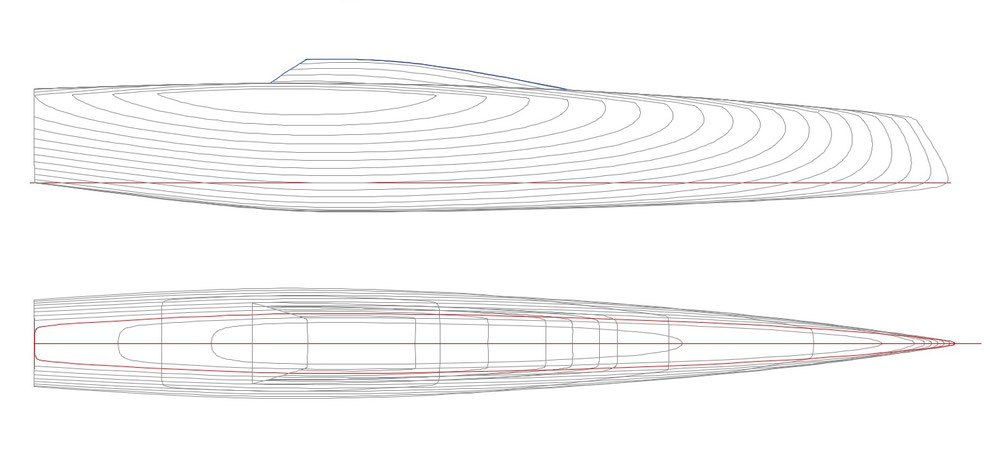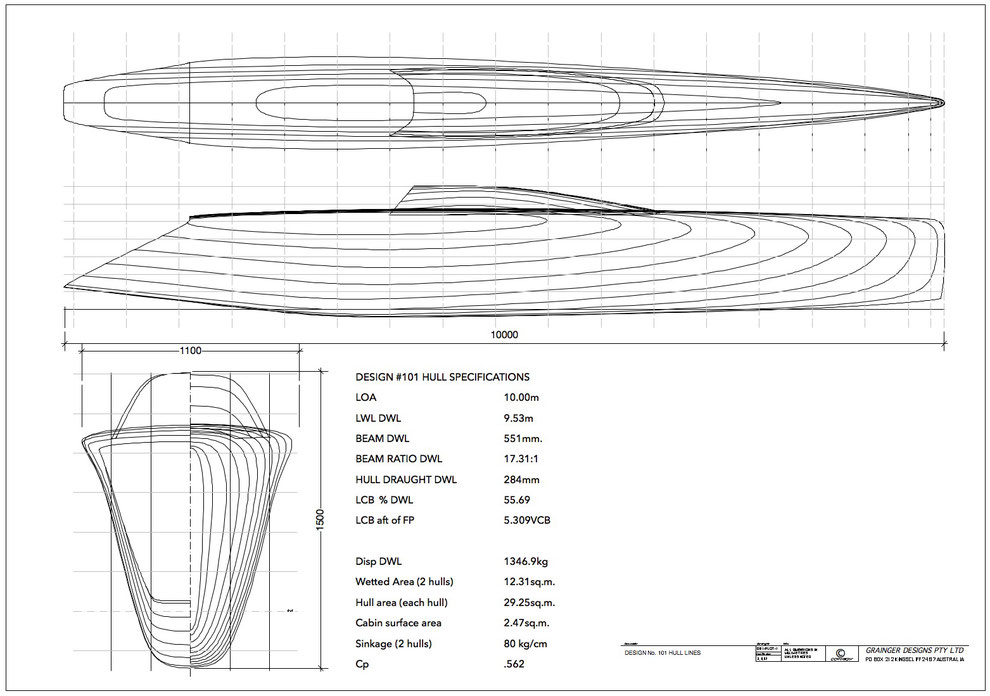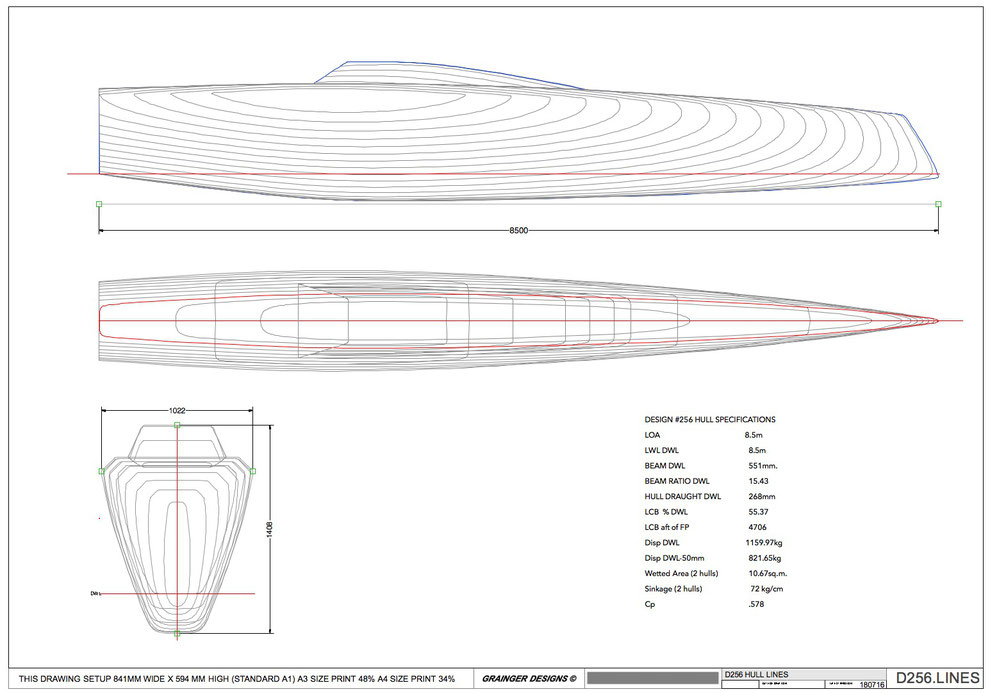Optimising Hull Lines for Performance
This article was inspired by a question about the rocker line in the new 8.5m cat Design 256 and I want to stick to the point, so we won’t turn it into a book, but I’ll discuss two issues, hull fineness ratio and some aspects of the rocker profile.
When you manipulate the hull form you’re adjusting the lines in three planes, waterplanes (plan view), buttocks (side view including the keel rocker) and the section shapes. So you need to be aware of how the shapes are changing in the other two planes as you manipulate any one of these three, or all three globally as is now possible with computer modelling.
There are two fundamental constants that you start with and don’t change throughout the process. The big one is the displacement or the amount of buoyancy you need.
If you make the hull finer by narrowing the waterlines you have to increase the draft or make the ends fuller to get back to the required displacement number.
If you flatten the rocker line you have to increase the hull width, fill out the ends, or square up the section shapes rather than having a V or rounded V.
The other constant is the longitudinal centre of buoyancy. You really can’t do any meaningful shaping of the hull form until you have settled on the these two constants.
A third number that we can plug in as a constant if we want to is the prismatic coefficient which describes bow much volume there is end the ends relative to the cross section shape in the middle of the boat, but in sailing boats this is of less importance compared to other factors.

The hull lines for Design 256, 8.5m Cat. It's that hump in the rocker line - right under the back of the cabin that brought up the question and is one of the key points discussed here.
Hull fineness.
Fine hulls are fast, but only in the higher speed range. There’s a misconception I come across quite a bit that you can add weight and windage and you’ll still be fast as long as your hulls are fine.
Well you won’t be. Your boat will simply sink to find the new state of equilibrium. If your transoms are submerged you’ll have more drag. If your bridge deck is too close to the water you’ll have slamming. Much better to be conservative with your displacement figure in the design stage than overly optimistic.
And fine hulls have more wetted area so you have more drag in light air where friction resistance is the primary drag factor.
I’ve seen promotional material for catamarans stating that the boat has less wetted area because it has fine hulls. For a given displacement the minimum wetted area is described by a sphere (or a semi sphere in the case of a floating object). The more you stretch it out in length, keeping the displacement constant, the more wetted area you have.
The more you make the section shape into a deep V or a broad U with tight corners, as opposed to a semicircle, the more wetted area you have. Add into the equation finer hulls are slower to tack.
So fine hulls are only an advantage if your boat is light and has enough sail area to ensure you’re travelling at speeds where form resistance is greater than skin resistance.
In my view the advantage of fine hulls is often overrated as it applies to cruising cats.
At the other end of the scale the resistance curve is fairly flat up to about 1:9 which is still quite fast in most conditions. From there the resistance rises steeply as the hull gets fatter and at 1:8 and fatter you’re suffering from some serious form drag.

This is the rocker line isolated from the lines plan above (in blue) and and the red line shows a more moderate rocker line that achieves the same buoyancy and maintains the centre of buoyancy in the same position. The bow is to the right.
In the image lower right I've squashed it up and increased the height to make the difference in the lines more obvious.
The difference in the two lines is quite subtle, but races are often won or lost by seconds.
Rocker Profile
So if we’re looking for low wetted area we would want a rocker profile that was even and rounded, relatively deep in the middle and rising smoothly to the surface at each end. But this would give us a low prismatic which is not ideal in the higher speed range, and it’s not ideal for pitch damping which in my view is the critical design factor that is often underrated.
Pitching is slow. It destroys the airflow in your sails and the flow around the hulls, and your performance is suffering from slamming loads.
The single most effective way to counter pitching is with asymmetry in the water planes. You can achieve that in the with a fine bow and broad transom. Or you can achieve it with V sections forward and a flattened U shape aft. Or you can achieve it in the profile view with a very straight run forward and a bump in the aft sections. A flatter rocker line is better for resisting pitching than an evenly curved one with deeper draft in the middle.
The final result is a combination of all three of these factors.
On a cat like Design 256 the weight is concentrated well aft so we need to get buoyancy well aft.
The kink you see in the rocker profile helps to do this. It also helps to keep the rocker straight for most of its length and smooth the water flow exiting the hull aft at higher speeds, possibly promoting some planing effect.
If we had a more even rocker line we would slightly reduce the wetted area, but we would increase the pitching and the water would exit the hull aft at a steeper angle, increasing form drag in the higher speed range.
How much of a bump can you put in there without creating a flow separation, and how damaging would that flow separation be? I really don’t know. The way all of these factors interplay in the various conditions we sail in is very complex.
Ultimately a lot of this work is gut feel nurtured by experience, observing things in nature and most importantly experimenting and trying new ideas.
Is the new Groupama AC45 a breakthrough that will influence the form of racing catamarans into the future? I don’t think anyone has a computer that can answer that. We have to wait and see.

Symmetric and non symmetric water-planes. The blue line with grey fill is the DWL from the design above. As is typical with modern cat hulls the bow is long and fine, the stern is full and rounded. This is the asymmetry that has a damping effect on pitching. The red line on the other hand is more like you would see on a double ended monohull and quite a few multihulls have also used this shape in the past. It's quite symmetric about the pitch axis and does not have good pitch resistance.
The hull lines of the new 8.5m Sports Cat Design 256

Mad Max, Previously Carbon Copy. She was designed in 1997 but she's the current (2016) title holder of the Australian Multihull Chamionships (2 successive years) and the fastest inshore racing boat in Australian waters.


